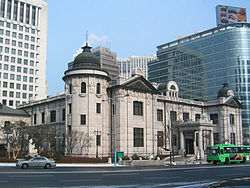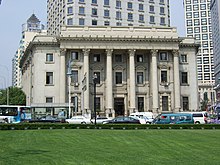Chosen Ginko
| Chosen Ginko | |
|---|---|

Former headquarters of the Chosen Ginko. July 11, 1909, completed in 1912, 7588 m² area. Architect Tatsuno Kingo (under monument protection since 1973, currently museum of the ”Bank of Korea; Photo 2005”)
|
|
| Japanese name | |
| Kanji | 朝鮮 銀行 |
| Rōmaji after Hepburn | Chosen Ginko |
| translation | Bank of Chosen |
| Korean name | |
| Hangeul | 조선 은행 |
| Hanja | 朝鮮 銀行 |
| Revised Romanization | Joseon Eunhaeng |
| McCune-Reischauer | Chosǒn Ŭnhaeng |
| translation | Bank of Joseon |
The Chōsen Ginkō was the central bank of the peninsula during the Japanese rule over Korea (1905 / 10-45). Your banknote privilege to issue the Korean yen extended after 1913 to the leased areas of Kwantung . At the same time, the normal yen notes of the Nippon Ginkō were also valid.
Foundation and structure
In the Korean Empire were after the forced opening and reinforced after the Treaty of Shimonoseki quickly dominant (1895) Japanese merchants. A functioning financial system and standardized currency did not yet exist in Korea. The first Japanese institute to issue banknotes in 1902 was the Dai-Ichi Kangyo Bank of Shibusawa Eiichi, which was set up in 1878 . A right that was secured by the First Japanese-Korean Agreement including Monetary Union in 1904. After Korea was annexed to the Japanese Empire as a new province under the name Chōsen in 1910 , the governor-general decided to create the Kankoku Ginkō ( Japanese 韓国 銀行 ; Kor. 한국 은행 , 韓國 銀行 , Hangug Eunhaeng; dt. Bank of Korea), their name was soon changed to Chosen Ginko . The entire board of directors, a governor and at least three directors, were appointed by the government. From the group of shareholders who owned at least fifty shares, the general meeting elected two inspectors to the board of directors.
The existence of this bank was limited in the statutes to 50 years, calculated from the date of foundation, to July 26, 1959. Of the 70,000 shares initially issued, 2000 were reserved for the imperial budget and 400 for the directors and auditors. The remaining 67,600 were placed on the market, the offer was oversubscribed 304 times. In March 1911 a law was passed that laid down the nature and scope of business operations. At the same time the capital was increased by 3 million, the 3,000 new shares remained in the possession of the government. For the imperial treasury you were the house bank.
The bank had a similar function for Chōsen as the Taiwan Ginkō did for this island, but its capital was almost entirely in private hands. With regard to the financing of infrastructure measures, such as railroad construction - also in Manchuria - one worked with the Yokohama Specie Bank and the semi-public mortgage bank Nippon Kangyō Ginkō . The bank was an instrument of imperialism as the highest form of capitalism. Initially, an upper limit of 30 million was set for the issue of banknotes, this amount could be exceeded with the approval of the Governor General, but then a 5% tax was due.
Business operations
Immediately after the First World War, there were 24 branches in Chosen . In addition to its central bank function, it also acted as a normal commercial bank in the area of short-term trade finance and stock exchange transactions. The capital was increased to ¥ 80 million by 1922. In the 1920s, there was no hesitation in funding smuggling operations in northern China in order to further destabilize the region.
Branches were opened in all of the major Chinese trading ports, Manchuria, as well as in London and New York.
The Tokyo branch was burgled on the night of January 15, 1932, in which ¥ 780,000 were stolen. The perpetrators were caught a few days later.
Of the poorly secured government bonds issued in 1923, they held around £ 2 million, so that the Shōwa financial crisis from April 1927 onwards affected them but did not slide into bankruptcy. After the Soviet banking supervisory authority threatened to close the branch in Vladivostok in 1924 , it did so at the end of 1930 after the local director was arrested for manipulating the exchange rate against the ruble.
They helped found the National Bank of China ( Chinese 中華 國家 銀行 ) in Beijing in 1930 to meet the needs of the Japan-friendly Marshal Yan Xishan . In the fighting that followed the Mukden incident (1931), the Harbin branch was bombed. For the Chinese provinces, Chahar , Rehe and Hebei ("Autonomous Military Council of East Hopei"), which came under Japanese control in 1933-5 , the Chōsen Ginkō was de facto the central bank (in the so-called "Yen Block"). As of September 30, 1937, banknotes had been issued for 204 million yen, up 49 million yen from the previous year.
Together with the Industrial Bank of Chōsen, founded in 1918 (focus on land and real estate investments), they controlled about half of Korean bank capital and deposits before the war, a large part of which came from the large industrial Zaibatsu .
1946 to 1950
After independence from Japan, the US occupiers in South Korea took over the house, initially as a central bank, and the currency was changed to won . The Bank of Korea , founded on June 12, 1950, took over the institute.
Like the other semi-public banks, the Japanese operation was affected by the SCAP's liquidation order of October 1945.
Banknotes
The first banknotes were issued in 1909 (1, 5, 10 ¥). Two years later, a 100-yen note followed, showing an obviously satisfied merchant carrying two bales of rice with a sack of money over his shoulder. The second series issued that year (1, 5, 10 ¥) already shows the “old man.” From 1913, banknotes were also legal tender in the Kwantung lease area . Until the First World War, the notes bore the English annotation "... Yen in Gold or Nippon Ginko Note." The small change notes for 10, 20, 50 Sen (1919–1932) “payable in Japanese currency at any of its Manchurian offices,” then, except for the currency, used western writing. The design of the 1944 series differed little from its predecessors. In 1945 the first ¥ 1000 note appeared.
From September 1945 to May 1946 new banknotes of different denominations were issued four times, with the paulownia , the national tree of Japan, being replaced by the hibiscus flower . These notes were called for redemption on November 3, 1950.
literature
- Chosen Ginko; A brief review of the Bank of Chosen; Seoul 1918.
- Condelario, Richard Paul; History of the Bank of Chosen, central bank of Korea, 1910-1948, and its mission in the future of Korea; Thesis (MA) - George Washington University, 1950.
- Bank of Chosen; Pictorial Chosen and Manchuria: Comp. in commemoration fo the decennial of the Bank of Chosen; Seoul 1919.
- Horesh N .; Between copper, silver and gold: Japanese banks of issue in Taiwan, northeast China and Korea, 1879-1937; China Report, Vol. 48 (2012), No. 4, pp. 375-392.
- Hoshino Teiji; Economic History of Manchuria: Compiled in commemoration of the decennial of the bank of Chosen; Seoul, Chosen, 1921.
Individual evidence
- ↑ MONETARY AND COMMERCIAL. . In: The Advertiser (Adelaide, SA: 1889-1931) , National Library of Australia, Nov. 30, 1909, p. 5. Retrieved April 16, 2013.
- ↑ For the relationship see: 日中 戦 争 期 に い た る 朝鮮 銀行 と 横 浜 正 金 銀行 ( Memento of the original from September 8, 2014 in the Internet Archive ) Info: The archive link was inserted automatically and has not yet been checked. Please check the original and archive link according to the instructions and then remove this notice. (PDF; 1.2 MB); Chuo-Gakuin University review of economics & commerce 6 (2), 73-92, March 31, 1992.
- ↑ KOREAN BANK ROBBERY. . In: The Sydney Morning Herald (NSW: 1842–1954) , National Library of Australia, January 19, 1932, p. 9. Retrieved April 16, 2013.
- ↑ The characters 園 on the notes remained the same. Exchange 1 for 1.
- ↑ For the expansion see: 金子 史 男; 第 一次 大 戦 期 に お け る 植 民 地 銀行 体系 の 再 編成: 朝鮮 銀行 の 「満 洲」 進出 を 中心 に; Journal of the agrarian history 21 (2), 1-21, January 20, 1979.
- ↑ cf .: 1910 年代 満 州 に お け る 朝鮮 銀行 券 の 流通 と 地域 経 済; Shakai-keizai-shigaku 68 (2), 127-144, July 25, 2002.


